钯碳 水合肼 还原 硝基
Pd C催化水合肼还原法制备邻氨基苯酚 韦长梅

2.4 催化剂用量的影响 固定对硝基苯酚 、水合肼用量分别是 1.390 和 1.300 g , 95 %乙醇为溶剂 , 升温至回流温度 , 反应时间
为 4 h , 考察催化剂用量对产物收率的影响 , 结果如表 4 所示 . 由表 4 见 , 收率随催化剂用量的增加而增加 , 综合考虑收率与催化剂的价格两方面因素 , 催化剂的
图 1 水合肼还原邻硝基苯酚制备邻氨基苯酚反应原理
近年来的研究表明 , 水合肼还原芳硝基化合物为芳胺是一条对环境友好 、简单易行的途径[ 7 ~ 8] .本 文采用 Pd/ C 催化下 , 用水合肼还原邻硝基苯酚制备邻氨基苯酚(反应原理见图 1), 同时研究还原反应 的时间 、温度 、催化剂用量和还原剂用量对产品收率的影响 .
可能归属
质子 a 质子 b 质子 c 质子 d 质子 e 质子 f
结构式
产量与收率 45 ~ 50
产量/g
0.62
反应温度/ ℃ 55 ~ 60 65 ~ 70
0.70
0.79
75 ~ 80 0.88
收率/ %
56.97
64.29
72.87
80.73
第3期
韦长梅 :Pd/ C 催化水合肼还原法制备邻氨基苯酚
产量/ g 收率/ %
2.0 0.66 60.55
2.5 0.78 71.56
反应时间/ h
3.0
3.5
0.88
0.91
80.73
83.49
4.0 0.95 87.16
4.5 0.96 88.07
由表 3 可见 , 随着反应时间的增加产物收率逐渐提高 , 当超过 4 h , 收率增加幅度降低 , 考虑效率因 素 , 硝化反应的合适时间为 4 h .
硝基还原的方法

硝基还原的方法2.用催化氢化,除了你提到的催化剂,还有Pt、Ni等催化剂,温和还原的话(室温稍加压)可以只还原硝基;3.氢化锂铝,这是比较强的还原剂,除了双键三键之外全部还原。
以上均还原为氨基。
以下是硝基苯的一些特征还原反应:4.用锌在弱酸性条件下还原为苯基羟胺;5.用锌在碱性条件下还原,水溶液得偶氮苯,醇溶液得氢化偶氮苯。
暂时就能想到这些,机理是在是太繁琐了,建议找专业书籍来看。
硝基还原中各种反应过渡态如出现亚硝基偶氮连氨等是不可避免的跟踪反应时通常能看到很多反应点个人认为楼主的情况首选尝试延长反应时间(同时建议降低反应温度),一般继续反应会将这些中间体基本还原彻底如果还不行是不是可以考虑改变氢化条件如催化剂用pd/c(虽然它的活性在碱性条件下会有所降低)供氢体采用肼等虽然加入少量碱性物质如三乙胺、氨甲醇溶液、氢氧化锂等能大大提高催化剂的活性但还原硝基化合物除外虽然加入少量碱性物质如三乙胺、氨甲醇溶液、氢氧化锂等能大大提高催化剂的活性\中的催化剂是指活性镍不是pd/c活性镍在中性和弱碱介质中能起到良好的催化作用,在弱碱性介质中效果更好Pd/C在酸性和碱性介质中都能起到催化作用,只是碱性条件下活性稍微降低最近看到很多虫子求助氢化的问题,就氢化这个反应我在这里做个肤浅阐述,还请大家批评指正.氢化反应在有机合成化学中发挥了很重要的作用,该反应不仅操作简单,而且后处理相当方便,因此得到了广泛的运用,通过氢化反应可以实现碳碳不饱和键的还原,一系列伯胺的合成,保护基的脱除等等.具体表现:碳碳双键,三键的氢化;腈基,硝基,叠氮基,肟的还原;Cbz,苄基脱除去保护;羟基的脱除或卤素(Cl,Br,I)的脱除以及一些杂芳环的氢化等等。
而氢化所用到催化剂一般为PtO2,Pd/C,Pd(OH)2/C,RaneyNi等。
1.不饱和键的氢化;双键氢化包括一般烯烃和不饱和酮(酯)的双键的氢化,一般烯烃双键的氢化需要加热加压才能反应.例如:与芳环共轭的烯烃氢化一般需要50-60pi的压力。
水合肼还原芳硝基物的研究
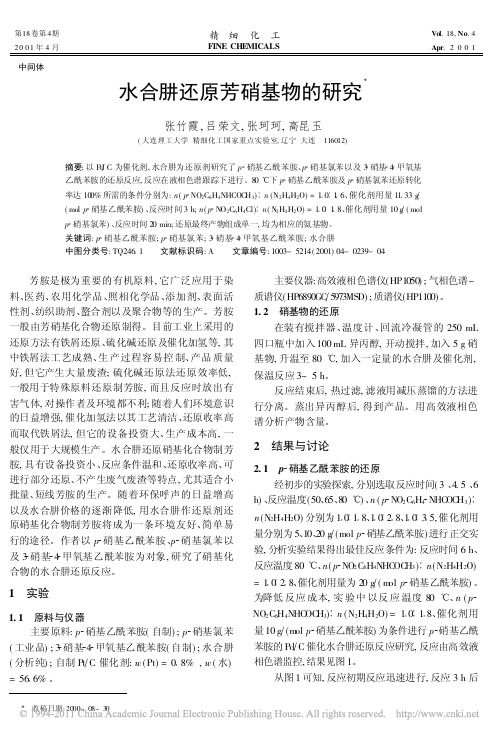
第18卷第4期2001年4月精细化工FINE CHEMICALSVol.18,No.4Apr.2001中间体水合肼还原芳硝基物的研究张竹霞,吕荣文,张珂珂,高昆玉(大连理工大学精细化工国家重点实验室,辽宁大连 116012)摘要:以Pd C为催化剂,水合肼为还原剂研究了p 硝基乙酰苯胺、p 硝基氯苯以及3 硝基 4 甲氧基乙酰苯胺的还原反应,反应在液相色谱跟踪下进行。
80 下p 硝基乙酰苯胺及p 硝基氯苯还原转化率达100%所需的条件分别为:n(p NO2C6H4NHCOC H3) n(N2H4H2O)=1 0 1 6、催化剂用量11 33g(mol p 硝基乙酰苯胺)、反应时间3h;n(p NO2C6H4Cl) n(N2H4H2O)=1 0 1 8、催化剂用量10g (molp 硝基氯苯)、反应时间20min;还原最终产物组成单一,均为相应的氨基物。
关键词:p 硝基乙酰苯胺;p 硝基氯苯;3 硝基 4 甲氧基乙酰苯胺;水合肼中图分类号:TQ246 1 文献标识码:A 文章编号:1003-5214(2001)04-0239-04芳胺是极为重要的有机原料,它广泛应用于染料、医药、农用化学品、照相化学品、添加剂、表面活性剂、纺织助剂、螯合剂以及聚合物等的生产。
芳胺一般由芳硝基化合物还原制得。
目前工业上采用的还原方法有铁屑还原、硫化碱还原及催化加氢等,其中铁屑法工艺成熟、生产过程容易控制、产品质量好,但它产生大量废渣;硫化碱还原法还原效率低,一般用于特殊原料还原制芳胺,而且反应时放出有害气体,对操作者及环境都不利;随着人们环境意识的日益增强,催化加氢法以其工艺清洁、还原收率高而取代铁屑法,但它的设备投资大、生产成本高,一般仅用于大规模生产。
水合肼还原硝基化合物制芳胺,具有设备投资小、反应条件温和、还原收率高、可进行部分还原、不产生废气废渣等特点,尤其适合小批量、短线芳胺的生产。
随着环保呼声的日益增高以及水合肼价格的逐渐降低,用水合肼作还原剂还原硝基化合物制芳胺将成为一条环境友好、简单易行的途径。
Pd/C 催化水合肼还原法制备对氨基苯乙酸
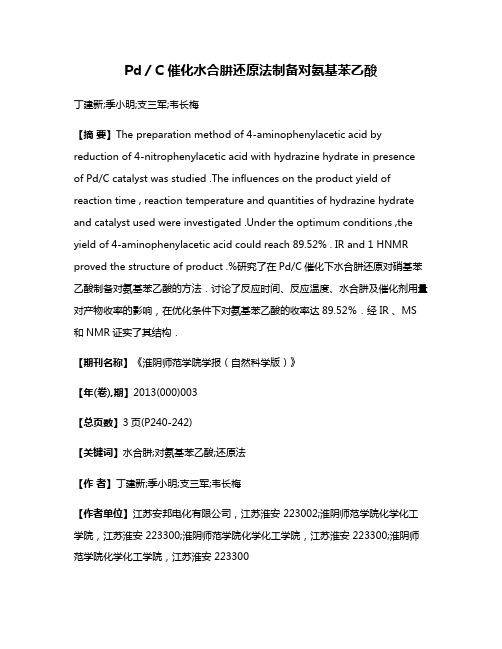
Pd/C 催化水合肼还原法制备对氨基苯乙酸丁建新;季小明;支三军;韦长梅【摘要】The preparation method of 4-aminophenylacetic acid by reduction of 4-nitrophenylacetic acid with hydrazine hydrate in presence of Pd/C catalyst was studied .The influences on the product yield of reaction time , reaction temperature and quantities of hydrazine hydrate and catalyst used were investigated .Under the optimum conditions ,the yield of 4-aminophenylacetic acid could reach 89.52% . IR and 1 HNMR proved the structure of product .%研究了在Pd/C催化下水合肼还原对硝基苯乙酸制备对氨基苯乙酸的方法.讨论了反应时间、反应温度、水合肼及催化剂用量对产物收率的影响,在优化条件下对氨基苯乙酸的收率达89.52%.经IR 、MS 和NMR证实了其结构.【期刊名称】《淮阴师范学院学报(自然科学版)》【年(卷),期】2013(000)003【总页数】3页(P240-242)【关键词】水合肼;对氨基苯乙酸;还原法【作者】丁建新;季小明;支三军;韦长梅【作者单位】江苏安邦电化有限公司,江苏淮安 223002;淮阴师范学院化学化工学院,江苏淮安 223300;淮阴师范学院化学化工学院,江苏淮安 223300;淮阴师范学院化学化工学院,江苏淮安 223300【正文语种】中文【中图分类】TQ620.6+3对氨基苯乙酸广泛应用于医药生产和有机合成原料生产中[1],可用于合成抗风湿药(阿克利他[2]),非甾体抗炎药(连苯乙酸,阿替洛尔),心脑血管药物(氨酰心安[3])等.因此,对氨基苯乙酸的制备研究具有重要的应用价值.芳胺通常由芳香硝基化合物还原制得[4].芳香硝基化合物还原的方法主要有:①催化加氢还原; ②硫化碱还原; ③铁粉在酸性、碱性、中性体系的还原法[5].以上方法都存在很多缺点.方法①高压加氢必须在高压封闭体系内反应,设备费用投资较大[5];方法②排放出大量含硫废水,严重危害生态环境,且“三废”处理投资较大,不符合绿色化学理念[6];方法③产生大量铁泥,产物纯度受到很大影响,还原产物不能直接用于药物合成[7],且催化剂不能重复使用[8-9].用水合肼作为还原剂,具有反应条件温和,还原选择性高,副产物为对环境无害的N2和H2O,后处理工艺简单等特点,符合绿色化学要求[10].Pd/C作为催化剂,应用于许多还原反应中,具有选择性强,性能稳定,不易中毒等特点,广泛应用于染料、医药工业及其他化工行业的加氢催化剂过程,而且可以回收再利用[11].作者对Pd/C催化80%水合肼还原对硝基苯乙酸制备对氨基苯乙酸的方法进行了研究,反应原理如下:1.1 药品与仪器异丙醇,质量分数为10%的Pd/C,水合肼(质量分数为80%),对硝基苯乙酸.试剂均为AP级.600E高效液相色谱仪(美国沃特斯); AVANCE 400MHz核磁共振波谱仪(瑞士布鲁克); Avarte360傅里叶变换红外光谱仪(美国Nicolet),KBr压片; XT-4双目显微熔点测定仪,温度计未校正.1.2 对氨基苯乙酸的制备将50mL异丙醇,4.525g(0.025mol)对硝基苯乙酸加入到250mL装有温度计的三口瓶中,开动磁力搅拌器,搅拌下加入Pd/C,搅拌下加热,升至指定温度,在30min内缓慢滴加水合肼,高效液相色谱跟踪反应,反应完成后趁热抽滤,滤渣用温水洗涤3次.将滤液蒸去部分异丙醇,冷却后所得固体用20mL乙醇-水重结晶,得到淡黄色片状晶体.2.1 表征熔点: 197~199℃(文献[12]:198~200℃) .IR表征(υmax): 3400~2600cm-1(O-H,N-H,=C-H伸缩振动), 1647cm-1,1598cm-1(苯环骨架振动), 1208,1180和1106cm-1(苯环的C-H面内弯曲振动), 818cm-1(N-H键弯曲振动).1HNMR表征: 对氨基苯乙腈的1H NMR分析结果见表1.2.2 反应温度的影响对硝基苯乙酸、Pd/C、水合肼的投料量分别为4.525,0.4和1.75g,反应时间为3h,考察反应温度对收率的影响(表2). 结果表明,随着反应温度的升高,收率逐渐增加,但从能耗方面考虑,适宜的反应温度为85~90℃.2.3 反应时间的影响对硝基苯乙酸、Pd/C、水合肼的投料量分别为4.525,0.4和1.75g,反应温度为85~90℃,考察反应时间对收率的影响(表3). 结果表明收率随反应时间的延长逐渐增加,但从能耗方面考虑,最佳反应时间为3h.2.4 催化剂用量的影响对硝基苯乙酸、水合肼的投料量分别为4.525g和1.75g,反应温度为85~90℃,反应时间为3h,考察催化剂用量对收率的影响(表4). 结果表明增加催化剂用量有利于提高收率,但考虑成本,适宜的催化剂用量为20g/mol对硝基苯乙酸,当对硝基苯乙酸投料量为4.525g时,催化剂用量为0.5g.2.5 还原剂用量的影响对硝基苯乙酸、Pd/C的投料量分别为4.525g和0.5g,反应温度为85~90℃,反应时间为3h,考察还原剂用量对收率的影响(表5). 结果表明增加还原剂用量有利于提高对氨基苯乙酸的收率,合适还原剂用量为N(硝基物)∶N(水合肼)=1∶2.0,当对硝基苯乙酸投料量为4.525g时,还原剂用量为2.0g.以对硝基苯乙酸为原料,在Pd/C催化下,水合肼还原制备对氨基苯乙酸的优化反应条件为:N(对硝基苯乙酸)∶N(水合肼)=1∶2.0,Pd/C用量为20g/mol硝基物,在85~90℃反应3h,对氨基苯乙酸收率为89.52%.该反应条件温和,后处理简单,产品易于纯化,副产物是对环境无害的物质N2和H2O.经过提纯的对氨基苯乙酸通过了IR和1H NMR表征.【相关文献】[1] 陈勇. 对氨基苯乙酸的合成[J]. 安阳师范学院学报:自然科学版,2000(4):34-35.[2] 周淑晶,白术杰,刘红.对氨基苯乙酸的制备[J]. 中国医药工业杂志,2006, 37(1):9-10.[3] 张建华. 对氨基苯乙酸合成工艺的改进[J]. 工艺研究,1990, 92(4):1-9.[4] 蔡可迎,马玉苗. 硒催化水合肼还原催化水合肼还原芳香族硝基化合物制芳胺[J]. 精细石油化工,2007, 24(6): 51-54.[5] 张竹霞,吕荣文,张珂珂,等. 水合肼还原芳硝基化合物的研究[J]. 精细化工, 2001, 18(4):239-242.[6] 唐洪,张蕾,徐寿颐. 芳香族硝基化合物的水合肼催化还原反应的研究[J]. 精细化工,1998,15(2):43-45.[7] 吕荣文,张竹霞,石奇勋,等. 芳硝基化合物的水合肼催化氢转移还原研究[R]. 上海:第九届全国染料与染色学术研讨会,2001.[8] Kumbhar P S, Valent J S, Millet J M, et al. Mg-Fe Hydrotalite as a catalyst for the reduction of aromatic nitro compounds with hydrazinc hydrate[J]. Journal of Catalysis, 2000, 191: 467-473.[9] Benz M, Kraan A M, Prins R. Reduction of aromatic nitro compounds with hydrazine hydrate in the presence of an iron oxide hydroxide catalyst III: The selective reduction of nitro groups in aromaticazo compounds[J]. Applied Catalysis A General, 1999, 177: 9-14.[10] 徐存进,邱化玉. Pd/C催化水合肼还原制备5-氨基-1,10-邻菲罗啉[J]. 杭州师范大学学报:自然科学版,2012,11(2):115-117.[11] 胡莉蓉,杨春辉,郭君. 水合肼作为还原剂在有机合成中的应用研究[J]. 化工时刊, 2012,26(4):41-43.[12] 樊能廷. 有机合成事典[M]. 北京:北京理工大学出版社,1992.。
氧化钯与水合肼反应方程式

氧化钯与水合肼反应方程式氧化钯与水合肼反应是一种常见的有机合成反应。
这个反应的方程式可以用以下方式表示:PdO + N2H4·H2O → Pd + N2 + 2H2O在这个方程式中,PdO代表氧化钯,N2H4·H2O代表水合肼,Pd 代表钯,N2代表氮气,H2O代表水。
氧化钯与水合肼反应是一种氧化还原反应。
在反应中,氧化钯PdO 被还原为钯Pd,同时水合肼N2H4·H2O被氧化成氮气N2和水H2O。
这个反应是一个典型的还原反应,因为氧化钯失去了氧原子,而水合肼获得了氧原子。
水合肼是一种无色液体,具有还原性。
在反应中,水合肼发生了氧化,所以它是反应的还原剂。
氧化钯是一种黑色固体,具有氧化性。
在反应中,氧化钯发生了还原,所以它是反应的氧化剂。
氧化钯与水合肼反应可以通过加热来进行。
在加热过程中,氧化钯和水合肼发生反应,产生钯和氮气。
这个反应的温度范围一般是50°C至100°C。
加热后,氧化钯和水合肼反应生成的产物可以通过过滤和洗涤来分离。
氧化钯与水合肼反应具有一定的应用价值。
钯是一种重要的催化剂,在化工、制药和其他领域中广泛应用。
水合肼可以作为一种还原剂,在有机合成中发挥重要作用。
氧化钯与水合肼反应可以产生钯和氮气,这对于钯的制备和应用具有一定的意义。
总结起来,氧化钯与水合肼反应是一种氧化还原反应。
在反应中,氧化钯被还原为钯,水合肼被氧化为氮气和水。
这个反应可以通过加热来进行,产物可以通过过滤和洗涤来分离。
这个反应具有一定的应用价值,对于钯的制备和应用有一定的意义。
Pd C催化水合肼还原法制备邻氨基苯酚 韦长梅

图 1 水合肼还原邻硝基苯酚制备邻氨基苯酚反应原理
近年来的研究表明 , 水合肼还原芳硝基化合物为芳胺是一条对环境友好 、简单易行的途径[ 7 ~ 8] .本 文采用 Pd/ C 催化下 , 用水合肼还原邻硝基苯酚制备邻氨基苯酚(反应原理见图 1), 同时研究还原反应 的时间 、温度 、催化剂用量和还原剂用量对产品收率的影响 .
[ 2] 邹耀洪 .海带脂肪酸邻氨基苯酚化学修饰 气相色谱 :质谱分析 [ J] .食品科学 , 2005, 26(9):411 414. [ 3] 郝允玲 , 姚莉 , 张武 , 等 .邻氨基苯酚 Schiff 碱多核配合物的合成与表征 [ J] .化学研究 , 2006, 17(3):16 18. [ 4] 高金昌 , 陈拴虎 , 石进超 .电解法合成邻氨基苯酚 [ J] .化学试剂 , 1995, 17(6):365 366. [ 5] 张强 , 宋东明 , 曹传贞 .液相加氢法制备邻氨基苯酚 [ J] .染料工 业 , 1997, 34(4):29 31. [ 6] 孙权一 .活性铁粉用作有机反应中的还原 剂 [ J] .化学 通报 , 1980, 3 (20):156 159.
2 35
由表 2 可知 , 随着温度的升高 , 收率增加 , 在 75 ~ 80 ℃(回流温度)时的产物收率为 80.73 %.值得注
意的是 , 在的较低温度下产物转化不完全 , 在产物中有亚硝基物 , 因此 , 可以推测邻硝基苯酚的还原是分
步进行的 , 硝基先转化为亚硝基 , 然后再由亚硝基转化为氨基 .
12实验操作100ml三口烧瓶中安装机械搅拌器冷凝管和温度计加入139go010too1研细的邻硝基苯酚30ml95乙醇和o010gpdc搅拌下加温温度升至70时加入130g水合肼继续升温并控制在7580回流反应4h趁热过滤pdc回收再利用滤液经减压蒸馏蒸去无水乙醇冷却后所得固体用10ml95乙醇重结晶得到对氨基苯酚淡黄色晶体o95g收率为8807
钯碳催化剂的应用和失活原因及再生
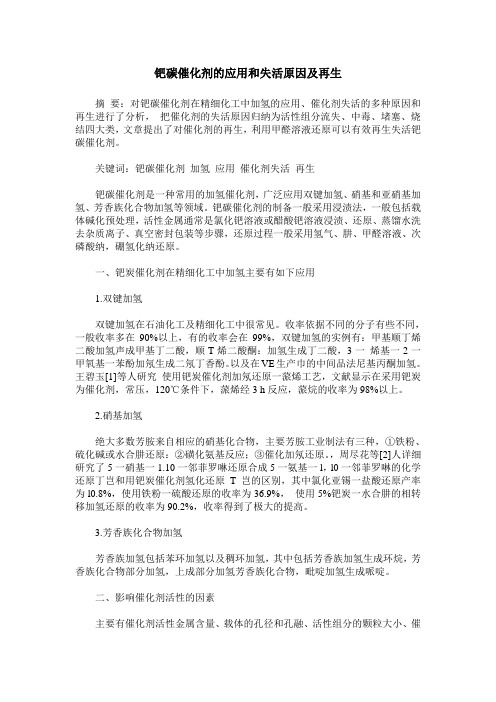
钯碳催化剂的应用和失活原因及再生摘要:对钯碳催化剂在精细化工中加氢的应用、催化剂失活的多种原因和再生进行了分析,把催化剂的失活原因归纳为活性组分流失、中毒、堵塞、烧结四大类,文章提出了对催化剂的再生,利用甲醛溶液还原可以有效再生失活钯碳催化剂。
关键词:钯碳催化剂加氢应用催化剂失活再生钯碳催化剂是一种常用的加氢催化剂,广泛应用双键加氢、硝基和亚硝基加氢、芳香族化合物加氢等领域。
钯碳催化剂的制备一般采用浸渍法,一般包括载体碱化预处理,活性金属通常是氯化钯溶液或醋酸钯溶液浸渍、还原、蒸馏水洗去杂质离子、真空密封包装等步骤,还原过程一般采用氢气、肼、甲醛溶液、次磷酸纳,硼氢化纳还原。
一、钯炭催化剂在精细化工中加氢主要有如下应用1.双键加氢双键加氢在石油化工及精细化工中很常见。
收率依据不同的分子有些不同,一般收率多在90%以上,有的收率会在99%,双键加氢的实例有:甲基顺丁烯二酸加氢声成甲基丁二酸,顺T烯二酸酮:加氢生成丁二酸,3一烯基一2一甲氧基一苯酚加氖生成二氖丁香酚。
以及在VE生产巾的中间品法尼基丙酮加氢。
王碧玉[1]等人研究使用钯炭催化剂加氖还原一蒎烯工艺,文献显示在采用钯炭为催化剂,常压,120℃条件下,蒎烯经3 h反应,蒎烷的收率为98%以上。
2.硝基加氢绝大多数芳胺来自相应的硝基化合物,主要芳胺工业制法有三种,①铁粉、硫化碱或水合肼还原:②磺化氨基反应;③催化加氖还原。
,周尽花等[2]人详细研究了5一硝基一1.10一邻菲罗啉还原合成5一氨基一l,l0一邻菲罗啉的化学还原丁岂和用钯炭催化剂氢化还原T岂的区别,其中氯化亚锡一盐酸还原产率为l0.8%,使用铁粉一硫酸还原的收率为36.9%,使用5%钯炭一水合肼的相转移加氢还原的收率为90.2%,收率得到了极大的提高。
3.芳香族化合物加氢芳香族加氢包括苯环加氢以及稠环加氢,其中包括芳香族加氢生成环烷,芳香族化合物部分加氢,上成部分加氢芳香族化合物,毗啶加氢生成哌啶。
芳香族硝基化合物的水合肼催化还原反应的研....

件组合。
计算书可以直接提交设计部门进行工业设计。
4 结论作者对从C 4齐聚物分离2, 4, 4-三甲基戊烯的过程进行了精密分离研究, 应用Aspen Plus 流程模拟系统为工作平台建立了数学模型, 结合精确的定性和定量分析以及精馏热模试验, 实现了最终目的产品2, 4, 4-三甲基戊烯纯度95%、收率98%的分离结果, 超出预计指标。
由于采用了以数学模型为中心的研究思路, 热模试验主要以验证数学模型计算结果为目标, 目的性强, 研究周期缩短。
参考文献[1] Aspen T ech , Aspen Plus Release 9. 1User . s Guide, Vol. l&Vol.2, 1994[2] 鲍杰等, 齐鲁石油化工, (4 , 221(1994[3] 汪文虎等, 烃类物理化学数据手册, 烃加工出版社, 1990 (1997-07-05收稿=作者简介>鲍杰, 1984年毕业于华东工程学院化学工程专业, 1984年在中石化齐鲁石化公司研究院工作至今。
先后从事化工过程开发、流程模拟和精细化工等领域的研究工作。
发表论文多篇。
Study on the Precision Separation of 2, 4, 4-Trimethylpentenefrom C 4OligomersBao Jie, An Yam ing, Ding Wenguang(Qilu Petr ochemical Research I nstitute, Zibo , Shandong Pr ovince, Pos tcode 255400Abstract:The precision separation of 2, 4, 4-trimethy lpentene from C 4oligomers w as studied. The flowsheet simulation model of the process in Aspen Plus platform w as built up and the accurate analysis and a few bench -tests w ere accomplished. The results show ed that the purity of 2, 4, 4-tirmethy lpentene w as over 95%and the recovery yield reached 98%.Keywords:oligomers, 2, 4, 4-trimethylpentene, precision separation, Aspen Plus芳香族硝基化合物的水合肼催化还原反应的研究唐洪张蕾徐寿颐(清华大学化学系, 北京, 邮编100084摘要研究了以80%水合肼为还原剂, 在FeCl 3#6H 2O/C 存在下, 回流3~8h, 将芳香族硝基化合物转变成芳香族氨基化合物的还原反应。
硝基还原的方法

经典的合成方法1.是Pd/C还原,用甲醇做溶剂,加4倍当量的甲酸铵,回流,最后过滤旋干,萃取就OK了,产率很高,没有副反应。
2.铁粉还原,铁粉是4倍当量的,加2倍当量的氯化铵,然后用水和乙醇作溶剂,水和乙醇的体积比是1:3,回流完毕后趁热过滤,冷却,可能就会有大量固体析出,如果没有的话就旋干,萃取。
3.硫化钠和硫代硫酸钠还原,很经典的4.用水合肼兰尼镍还原5.用LAH 或者NaBH4-BF3还原!!这些应该足够LZ还原了!我做过黄酮上面硝基的还原,甲醇溶剂,钯碳,水浴40°,2h就好了,产率可以达到85以上!~严重推荐!~Fe粉还原,欢迎拍砖已有2人参与★★★★★xiaopengs:恭喜,你的帖子被版主审核为资源贴了别人回复你的帖子对资源进行评价后,你就可以获得金币了理由:OK 2011-05-19 23:22xiaopengs(金币+5): 谢谢分享2011-05-19 23:24:44秋天白云(OCI+1): 欢迎你继续支持有机交流版!2011-05-25 14:20:37Fe粉还原自小虫进入本论坛以来,看见很多关于Fe还原的帖子,虽然这是一个简单的傻瓜反应,其机理与历程,通法与后处理都为广大科技工作者所熟知,但是其中或多或少存在着一些细节,本虫就本虫做过的几个Fe粉还原工业化对Fe粉还原进行简要的总结,以期和广大虫友交流,纯属抛砖引玉,妄论之处还请广大虫友不吝赐教(因为本人高中肄业,仅在一小化工厂当了10几年的操作工,目前处于失业状态,理论水平非常有限,参考书目给大家列出)。
Fe还原反应是通过电子的转移而实现的[1]。
即Fe是电子给体,被还原物的某个原子首先在Fe粉的表面得到电子生成负离子自由基,后者再从质子给体(例如水)得到质子而生成产物。
Fe的给电子能力比较弱,适用于容易被还原的基团的还原,是一种选择性还原剂,尤其是苯系硝基衍生物的还原,基本不影响苯环上其它基团(水不稳定性和热不稳定性基团除外)。
钯炭催化剂的失活原因概述

钯炭催化剂的失活原因概述钯炭催化剂是一种常用的加氢催化剂,广泛应用双键加氢、硝基和亚硝基加氢、芳香族化合物加氢等领域。
钯碳催化剂的制备一般采用浸渍法,一般包括载体碱化预处理,活性金属通常是氯化钯溶液或醋酸钯溶液浸渍、还原、蒸馏水洗去杂质离子、真空密封包装等步骤,还原过程一般采用氢气、肼、甲醛溶液、次磷酸纳,硼氢化纳还原。
一、钯炭催化剂在精细化工中加氢主要应用1.1双键加氢双键加氢在石油化工及精细化工中很常见。
收率依据不同的分子有些不同,一般收率多在90%以上,有的收率会在99%,双键加氢的实例有:甲基顺丁烯二酸加氢生成甲基丁二酸,顺T烯二酸酮,加氢生成丁二酸,3-烯基-2-甲氧基-苯酚加氢生成二氢丁香酚。
以及在VE生产巾的中间品法尼基丙酮加氢。
王碧玉等人研究使用钯炭催化剂加氢还原一蒎烯工艺,文献显示在采用钯炭为催化剂,常压,120℃条件下,蒎烯经3h反应,蒎烷的收率为98%以上。
1.2硝基加氢绝大多数芳胺来自相应的硝基化合物,主要芳胺工业制法有三种①铁粉、硫化碱或水合肼还原。
②磺化氨基反应。
③催化加氢还原。
周尽花等人详细研究了5-硝基-1.10-邻菲罗啉还原合成5-氨基-1,10-邻菲罗啉的化学还原丁岂和用钯炭催化剂氢化还原T岂的区别,其中氯化亚锡-盐酸还原产率为10.8%,使用铁粉-硫酸还原的收率为36.9%,使用5%钯炭-水合肼的相转移加氢还原的收率为90.2%,收率得到了极大的提高。
1.3芳香族化合物加氢芳香族加氢包括苯环加氢以及稠环加氢,其中包括芳香族加氢生成环烷,芳香族化合物部分加氢,上成部分加氢芳香族化合物,毗啶加氢生成哌啶。
二、影响催化剂活性的因素主要有催化剂活性金属含量、载体的孔径和孔融、活性组分的颗粒大小、催化剂表面结构以及金属Pd在载体上的分布状况等。
上述影响因素主要与浸渍方法、漫渍液浓度、干燥介质和温度、还原方式有关。
陈信华指出催化剂制备过程中浸渍方法、干燥温度是影响催化剂表面活性金属含量的主要因素,还原方法则是影响催化剂上活性金属颗粒大小的主要因素,而表面金属含量和金属颗粒大小会很大程度上影响催化剂的活性。
钯碳还原 溶剂
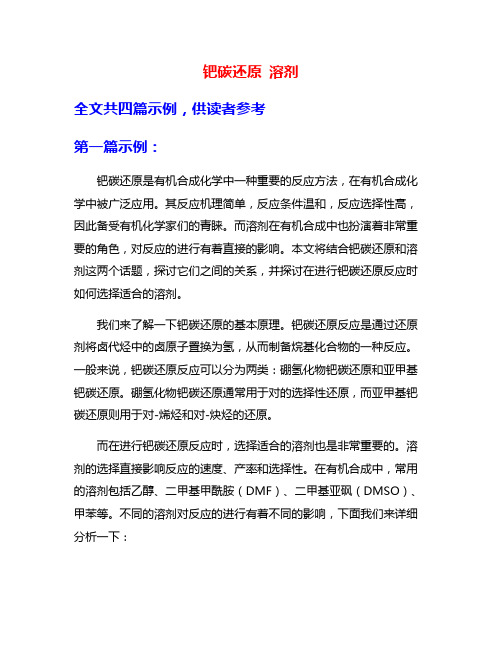
钯碳还原溶剂全文共四篇示例,供读者参考第一篇示例:钯碳还原是有机合成化学中一种重要的反应方法,在有机合成化学中被广泛应用。
其反应机理简单,反应条件温和,反应选择性高,因此备受有机化学家们的青睐。
而溶剂在有机合成中也扮演着非常重要的角色,对反应的进行有着直接的影响。
本文将结合钯碳还原和溶剂这两个话题,探讨它们之间的关系,并探讨在进行钯碳还原反应时如何选择适合的溶剂。
我们来了解一下钯碳还原的基本原理。
钯碳还原反应是通过还原剂将卤代烃中的卤原子置换为氢,从而制备烷基化合物的一种反应。
一般来说,钯碳还原反应可以分为两类:硼氢化物钯碳还原和亚甲基钯碳还原。
硼氢化物钯碳还原通常用于对的选择性还原,而亚甲基钯碳还原则用于对-烯烃和对-炔烃的还原。
而在进行钯碳还原反应时,选择适合的溶剂也是非常重要的。
溶剂的选择直接影响反应的速度、产率和选择性。
在有机合成中,常用的溶剂包括乙醇、二甲基甲酰胺(DMF)、二甲基亚砜(DMSO)、甲苯等。
不同的溶剂对反应的进行有着不同的影响,下面我们来详细分析一下:乙醇是一种常用的溶剂,对于一些简单的钯碳还原反应来说是一个比较好的选择。
乙醇的挥发性较低,能够提供一个相对稳定的反应环境,同时乙醇和水的共存可以促进还原反应的进行。
对于一些需要高温条件下进行的钯碳还原反应来说,乙醇并不是一个理想的选择,因为其沸点较低,会导致反应溶液的挥发,降低反应的效率。
DMF是一种强极性溶剂,可以溶解绝大多数有机物,对于一些难溶解的反应物来说是一个非常好的选择。
在钯碳还原反应中,DMF的选择性好,并且可用于催化钯还原反应。
但DMF也有一些缺点,比如其毒性较大,对操作人员的危害较大,因此在使用时需要注意安全。
DMSO也是一种常用的溶剂,在一些高效的钯碳还原反应中有着广泛的应用。
DMSO可以提供良好的溶解性能,同时它的极性也比较高,有利于氢和卤代烃之间的置换反应。
但要注意的是,DMSO对于某些催化剂有着腐蚀性,需注意配合反应条件的选择。
水合肼 还原胺化

水合肼还原胺化
水合肼是一种常用的还原剂,具有极强的还原能力。
在化学反应中,水合肼主要用于羰基化合物的还原。
例如,羰基化合物与等摩尔量的水合肼在正丁醇中回流反应,可以制备腙。
此外,利用水合肼进行还原胺化的反应也是研究的重点。
一种方法是在氢氧化钠或氢氧化钾作用下,使羰基化合物直接与水合肼发生还原反应,从而被广泛用于各种酸敏底物的还原。
在此过程中,羰基化合物的其他不饱和基团(例如:双键等)不受影响。
另一种方法是通过Pd/C或Raney Ni催化加氢还原硝基的方式,将硝基还原为胺,这也是合成胺的最干净和简便的还原方法。
然而,这种方法的缺点是条件比较强,卤素和双键,炔键可能会被还原。
水相微波辅助的铂-铈双金属催化水合肼还原硝基芳烃
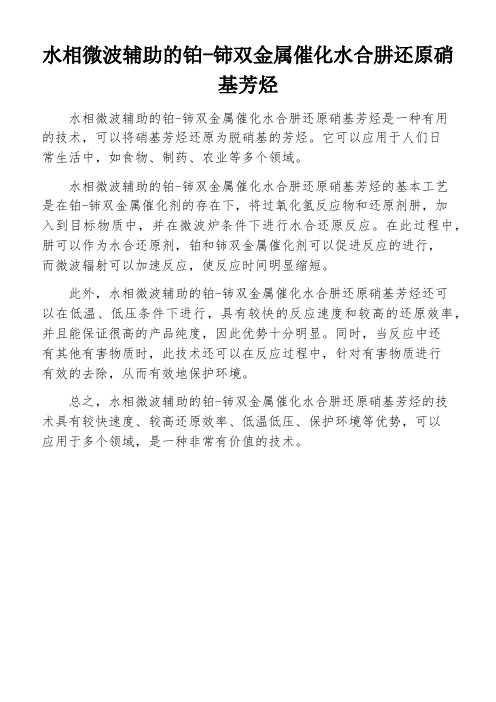
水相微波辅助的铂-铈双金属催化水合肼还原硝
基芳烃
水相微波辅助的铂-铈双金属催化水合肼还原硝基芳烃是一种有用
的技术,可以将硝基芳烃还原为脱硝基的芳烃。
它可以应用于人们日
常生活中,如食物、制药、农业等多个领域。
水相微波辅助的铂-铈双金属催化水合肼还原硝基芳烃的基本工艺
是在铂-铈双金属催化剂的存在下,将过氧化氢反应物和还原剂肼,加
入到目标物质中,并在微波炉条件下进行水合还原反应。
在此过程中,肼可以作为水合还原剂,铂和铈双金属催化剂可以促进反应的进行,
而微波辐射可以加速反应,使反应时间明显缩短。
此外,水相微波辅助的铂-铈双金属催化水合肼还原硝基芳烃还可
以在低温、低压条件下进行,具有较快的反应速度和较高的还原效率,并且能保证很高的产品纯度,因此优势十分明显。
同时,当反应中还
有其他有害物质时,此技术还可以在反应过程中,针对有害物质进行
有效的去除,从而有效地保护环境。
总之,水相微波辅助的铂-铈双金属催化水合肼还原硝基芳烃的技
术具有较快速度、较高还原效率、低温低压、保护环境等优势,可以
应用于多个领域,是一种非常有价值的技术。
钯碳还原 溶剂
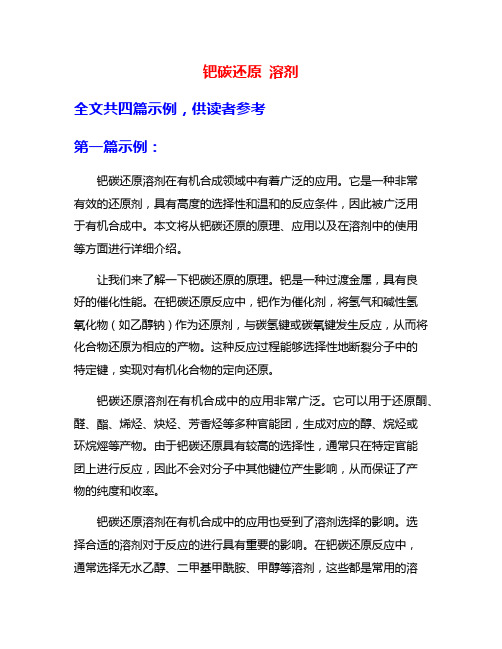
钯碳还原溶剂全文共四篇示例,供读者参考第一篇示例:钯碳还原溶剂在有机合成领域中有着广泛的应用。
它是一种非常有效的还原剂,具有高度的选择性和温和的反应条件,因此被广泛用于有机合成中。
本文将从钯碳还原的原理、应用以及在溶剂中的使用等方面进行详细介绍。
让我们来了解一下钯碳还原的原理。
钯是一种过渡金属,具有良好的催化性能。
在钯碳还原反应中,钯作为催化剂,将氢气和碱性氢氧化物(如乙醇钠)作为还原剂,与碳氢键或碳氧键发生反应,从而将化合物还原为相应的产物。
这种反应过程能够选择性地断裂分子中的特定键,实现对有机化合物的定向还原。
钯碳还原溶剂在有机合成中的应用非常广泛。
它可以用于还原酮、醛、酯、烯烃、炔烃、芳香烃等多种官能团,生成对应的醇、烷烃或环烷烴等产物。
由于钯碳还原具有较高的选择性,通常只在特定官能团上进行反应,因此不会对分子中其他键位产生影响,从而保证了产物的纯度和收率。
钯碳还原溶剂在有机合成中的应用也受到了溶剂选择的影响。
选择合适的溶剂对于反应的进行具有重要的影响。
在钯碳还原反应中,通常选择无水乙醇、二甲基甲酰胺、甲醇等溶剂,这些都是常用的溶剂,可以提供适宜的反应环境,有利于反应的进行和产物的收率。
较好的溶解性能也能提高反应的效率,使反应均匀进行。
除了在有机合成中的应用外,钯碳还原溶剂还被广泛应用于重要的生物医药领域。
许多药物的合成中都需要还原反应,而钯碳还原溶剂的高效性和选择性则能够保证合成产物的纯度和收率,从而满足药物合成的要求。
在药物的合成研究中,钯碳还原溶剂也扮演着重要的角色。
钯碳还原溶剂在有机合成领域中有着广泛的应用前景。
它具有高选择性、温和的反应条件,能够实现对有机分子中特定键的定向还原。
选择合适的溶剂对于钯碳还原反应的进行也具有重要的影响。
随着有机合成和药物合成领域的不断发展,钯碳还原溶剂将继续发挥其重要作用,推动有机化学领域的发展。
第二篇示例:钯碳还原溶剂是一种常用的还原剂,广泛应用于有机合成化学领域。
- 1、下载文档前请自行甄别文档内容的完整性,平台不提供额外的编辑、内容补充、找答案等附加服务。
- 2、"仅部分预览"的文档,不可在线预览部分如存在完整性等问题,可反馈申请退款(可完整预览的文档不适用该条件!)。
- 3、如文档侵犯您的权益,请联系客服反馈,我们会尽快为您处理(人工客服工作时间:9:00-18:30)。
Organic Syntheses, Coll. Vol. 5, p.30 (1973); Vol. 40, p.5 (1960).2-AMINOFLUORENE[2-Flurenylamine]Submitted by P. M. G. Bavin1Checked by John C. Sheehan and Roger E. Chandler..1. ProcedureIn a 2-l. three-necked round-bottomed flask, equipped with a mechanical stirrer (Note 1), reflux condenser, and dropping funnel, are placed 30 g. of pure 2-nitrofluorene, m.p. 157° [Org. Syntheses, Coll. Vol. 2, 447 (1943)], and 250 ml. of 95% ethanol. After warming to 50° on a steam bath, 0.1 g. of palladized charcoal catalyst (previously moistened with alcohol) is added (Note 2) and the stirrer is started. About 15 ml. of hydrazine hydrate is added from the dropping funnel during 30 minutes (Note 3). At this point an additional 0.1 g. of catalyst (previously moistened with alcohol) is added and the mixture is heated until the alcohol refluxes gently. After 1 hour the nitrofluorene has dissolved completely and the supernatant liquor is almost colorless.The catalyst is removed by filtration with gentle suction through a thin layer of Celite (Note 4). The flask is rinsed with 30 ml. of hot alcohol which is then used to wash the catalyst and Celite. The combined filtrates are concentrated under reduced pressure to about 50 ml. (Note 5) and then heated to boiling at atmospheric pressure. When 250 ml. of hot water is added slowly, 2-aminofluorene is precipitated as a colorless, crystalline powder. After cooling in an ice bath, the 2-aminofluorene is collected, washed with water, and dried in the dark in a vacuum desiccator. The product melts at 127.8–128.8° (Note 6) and amounts to 24–25 g. (93–96%).2. Notes1. If the stirring is omitted, the nitrofluorene takes longer to dissolve.2. A suitable catalyst is 10% palladium-on-charcoal, such as is supplied by Baker and Company, Inc., 113 Astor Street, Newark 5, New Jersey.3. The reaction is exothermic, and too rapid addition of the hydrazine may cause the mixture to foam out of the condenser.4. Caution! The catalyst is often pyrophoric and should be kept moistened with alcohol. Celite is a diatomaceous earth filter aid.5. A rotary evaporator is very convenient for the concentration since some of the amine invariably crystallizes toward the end.6. The melting point is that reported in Organic Syntheses, Coll. Vol. 2, 448 (1943), for a recrystallized sample.3. DiscussionThe preparation of 2-aminofluorene reported previously in Organic Syntheses[Coll. Vol. 2, 448 (1943)] we based on the method of Diels.2The present procedure illustrates a general method for the reduction of aromatic nitro compounds to aromatic amines using hydrazine and a hydrogenation catalyst such as palladium, platinum, nickel, iron, or rethenium. The literature on this procedure up to 1963 has been reviewed.3 In many instances the catalytic hydrazine reductions give yields of amine equal to or better than those obtained by directcatalytic hydrogenation or other reduction methods. Both the apparatus and the procedure are simple. Under appropriate conditions the method may be used for the dehalogenation of aliphatic and aromatic halides,3 a reaction for which palladium appears to be a specific catalyst. The method has also been used for the reduction of azobenzene and azoxybenzene to hydrazobenzene (80–90%),4 as well as for the synthesis of steroid aziridines by reduction of mesylate esters by vicinal azido alcohols (using Raney nickel).5References and Notes1.National Research Council of Canada Post-doctorate Fellow, 1954-56, at the University ofOttawa, Ottawa, Ontario.2.O. Diels, Ber., 34, 1758 (1901).3. A. Furst, R. C. Berlo, and S. Hooton, Chem. Rev., 65, 51 (1965).4.P. M. G. Bavin, Can. J. Chem., 36, 238 (1958).5.K. Ponsold, Ber., 97, 3524 (1964).AppendixChemical Abstracts Nomenclature (Collective Index Number);(Registry Number)2-Flurenylaminepalladized charcoal catalystpalladium-on-charcoalethanol (64-17-5)iron (7439-89-6)platinum (7440-06-4)nickel,Raney nickel (7440-02-0)palladium (7440-05-3)hydrazine hydrate (7803-57-8)hydrazine (302-01-2)Azoxybenzene (495-48-7)Azobenzene (103-33-3)2-Nitrofluorene (607-57-8)2-Aminofluorene(153-78-6)Nitrofluoreneretheniumhydrazobenzene (122-66-7) Copyright © 1921-2005, Organic Syntheses, Inc. All Rights Reserved。
